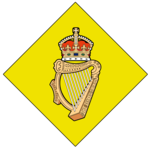| Auxiliary Division | |
|---|---|
 Badge of the Auxiliary Division (F Company) | |
| Active | July 1920 – April 1922 |
| Allegiance | |
| Type | Paramilitary |
| Role | Counter-insurgency |
| Size | 2,264 [1] |
| Part of | Royal Irish Constabulary |
| Engagements | |
| Commanders | |
| Notable commanders | Frank Percy Crozier |
The Auxiliary Division of the Royal Irish Constabulary (ADRIC), generally known as the Auxiliaries or Auxies, was a paramilitary unit of the Royal Irish Constabulary (RIC) during the Irish War of Independence. It was founded in July 1920 by Major-General Henry Hugh Tudor and made up of former British Army officers, most of whom came from Great Britain and had fought in the First World War. Almost 2,300 served in the unit during the conflict. Its role was to conduct counter-insurgency operations against the Irish Republican Army (IRA), acting mainly as a mobile striking and raiding force. It operated semi-independently of the RIC and was mainly deployed to southern and western regions where fighting was heaviest.
The Auxiliaries became infamous for reprisal attacks on civilians and civilian property in revenge for IRA actions, including extrajudicial killings and arson; most notably the burning of Cork city in December 1920.
The Auxiliaries were distinct from the so-called Black and Tans. These were also former British soldiers who were recruited into the RIC, but served as regular constables. Both groups wore a mixed uniform of British Army khaki and RIC dark green, although the Auxiliaries had their own insignia and typically wore Balmoral caps. The Auxiliaries and the RIC as a whole were disbanded in early 1922, following the Anglo-Irish Treaty.
- ^ "RIC and DMP policemen to be commemorated for first time by State". Irish Times, 1 January 2020.